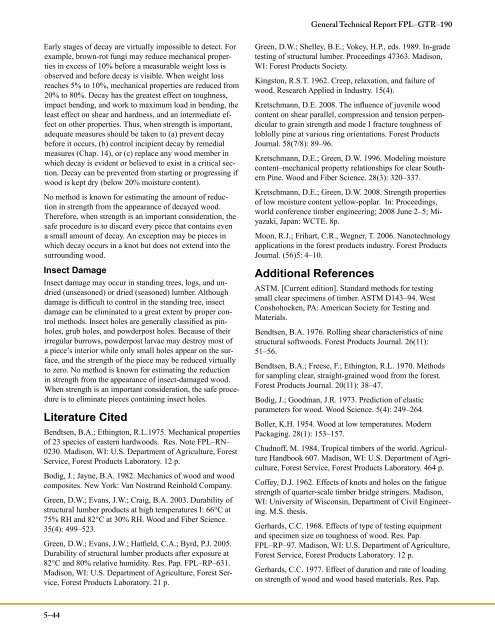Wood Handbook, Chapter 05: Mechanical Properties of Wood
Wood Handbook, Chapter 05: Mechanical Properties of Wood
Wood Handbook, Chapter 05: Mechanical Properties of Wood
Create successful ePaper yourself
Turn your PDF publications into a flip-book with our unique Google optimized e-Paper software.
Early stages <strong>of</strong> decay are virtually impossible to detect. For<br />
example, brown-rot fungi may reduce mechanical properties<br />
in excess <strong>of</strong> 10% before a measurable weight loss is<br />
observed and before decay is visible. When weight loss<br />
reaches 5% to 10%, mechanical properties are reduced from<br />
20% to 80%. Decay has the greatest effect on toughness,<br />
impact bending, and work to maximum load in bending, the<br />
least effect on shear and hardness, and an intermediate effect<br />
on other properties. Thus, when strength is important,<br />
adequate measures should be taken to (a) prevent decay<br />
before it occurs, (b) control incipient decay by remedial<br />
measures (Chap. 14), or (c) replace any wood member in<br />
which decay is evident or believed to exist in a critical section.<br />
Decay can be prevented from starting or progressing if<br />
wood is kept dry (below 20% moisture content).<br />
No method is known for estimating the amount <strong>of</strong> reduction<br />
in strength from the appearance <strong>of</strong> decayed wood.<br />
Therefore, when strength is an important consideration, the<br />
safe procedure is to discard every piece that contains even<br />
a small amount <strong>of</strong> decay. An exception may be pieces in<br />
which decay occurs in a knot but does not extend into the<br />
surrounding wood.<br />
Insect Damage<br />
Insect damage may occur in standing trees, logs, and undried<br />
(unseasoned) or dried (seasoned) lumber. Although<br />
damage is difficult to control in the standing tree, insect<br />
damage can be eliminated to a great extent by proper control<br />
methods. Insect holes are generally classified as pinholes,<br />
grub holes, and powderpost holes. Because <strong>of</strong> their<br />
irregular burrows, powderpost larvae may destroy most <strong>of</strong><br />
a piece’s interior while only small holes appear on the surface,<br />
and the strength <strong>of</strong> the piece may be reduced virtually<br />
to zero. No method is known for estimating the reduction<br />
in strength from the appearance <strong>of</strong> insect-damaged wood.<br />
When strength is an important consideration, the safe procedure<br />
is to eliminate pieces containing insect holes.<br />
Literature Cited<br />
Bendtsen, B.A.; Ethington, R.L.1975. <strong>Mechanical</strong> properties<br />
<strong>of</strong> 23 species <strong>of</strong> eastern hardwoods. Res. Note FPL–RN–<br />
0230. Madison, WI: U.S. Department <strong>of</strong> Agriculture, Forest<br />
Service, Forest Products Laboratory. 12 p.<br />
Bodig, J.; Jayne, B.A. 1982. Mechanics <strong>of</strong> wood and wood<br />
composites. New York: Van Nostrand Reinhold Company.<br />
Green, D.W.; Evans, J.W.; Craig, B.A. 2003. Durability <strong>of</strong><br />
structural lumber products at high temperatures I: 66°C at<br />
75% RH and 82°C at 30% RH. <strong>Wood</strong> and Fiber Science.<br />
35(4): 499–523.<br />
Green, D.W.; Evans, J.W.; Hatfield, C.A.; Byrd, P.J. 20<strong>05</strong>.<br />
Durability <strong>of</strong> structural lumber products after exposure at<br />
82°C and 80% relative humidity. Res. Pap. FPL–RP–631.<br />
Madison, WI: U.S. Department <strong>of</strong> Agriculture, Forest Service,<br />
Forest Products Laboratory. 21 p.<br />
5–44<br />
General Technical Report FPL–GTR–190<br />
Green, D.W.; Shelley, B.E.; Vokey, H.P., eds. 1989. In-grade<br />
testing <strong>of</strong> structural lumber. Proceedings 47363. Madison,<br />
WI: Forest Products Society.<br />
Kingston, R.S.T. 1962. Creep, relaxation, and failure <strong>of</strong><br />
wood. Research Applied in Industry. 15(4).<br />
Kretschmann, D.E. 2008. The influence <strong>of</strong> juvenile wood<br />
content on shear parallel, compression and tension perpendicular<br />
to grain strength and mode I fracture toughness <strong>of</strong><br />
loblolly pine at various ring orientations. Forest Products<br />
Journal. 58(7/8): 89–96.<br />
Kretschmann, D.E.; Green, D.W. 1996. Modeling moisture<br />
content–mechanical property relationships for clear Southern<br />
Pine. <strong>Wood</strong> and Fiber Science. 28(3): 320–337.<br />
Kretschmann, D.E.; Green, D.W. 2008. Strength properties<br />
<strong>of</strong> low moisture content yellow-poplar. In: Proceedings,<br />
world conference timber engineering; 2008 June 2–5; Miyazaki,<br />
Japan: WCTE. 8p.<br />
Moon, R.J.; Frihart, C.R., Wegner, T. 2006. Nanotechnology<br />
applications in the forest products industry. Forest Products<br />
Journal. (56)5: 4–10.<br />
Additional References<br />
ASTM. [Current edition]. Standard methods for testing<br />
small clear specimens <strong>of</strong> timber. ASTM D143–94. West<br />
Conshohocken, PA: American Society for Testing and<br />
Materials.<br />
Bendtsen, B.A. 1976. Rolling shear characteristics <strong>of</strong> nine<br />
structural s<strong>of</strong>twoods. Forest Products Journal. 26(11):<br />
51–56.<br />
Bendtsen, B.A.; Freese, F.; Ethington, R.L. 1970. Methods<br />
for sampling clear, straight-grained wood from the forest.<br />
Forest Products Journal. 20(11): 38–47.<br />
Bodig, J.; Goodman, J.R. 1973. Prediction <strong>of</strong> elastic<br />
parameters for wood. <strong>Wood</strong> Science. 5(4): 249–264.<br />
Boller, K.H. 1954. <strong>Wood</strong> at low temperatures. Modern<br />
Packaging. 28(1): 153–157.<br />
Chudn<strong>of</strong>f, M. 1984. Tropical timbers <strong>of</strong> the world. Agriculture<br />
<strong>Handbook</strong> 607. Madison, WI: U.S. Department <strong>of</strong> Agriculture,<br />
Forest Service, Forest Products Laboratory. 464 p.<br />
C<strong>of</strong>fey, D.J. 1962. Effects <strong>of</strong> knots and holes on the fatigue<br />
strength <strong>of</strong> quarter-scale timber bridge stringers. Madison,<br />
WI: University <strong>of</strong> Wisconsin, Department <strong>of</strong> Civil Engineering.<br />
M.S. thesis.<br />
Gerhards, C.C. 1968. Effects <strong>of</strong> type <strong>of</strong> testing equipment<br />
and specimen size on toughness <strong>of</strong> wood. Res. Pap.<br />
FPL–RP–97. Madison, WI: U.S. Department <strong>of</strong> Agriculture,<br />
Forest Service, Forest Products Laboratory. 12 p.<br />
Gerhards, C.C. 1977. Effect <strong>of</strong> duration and rate <strong>of</strong> loading<br />
on strength <strong>of</strong> wood and wood based materials. Res. Pap.

















